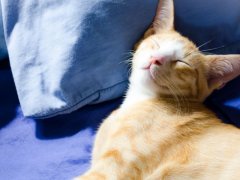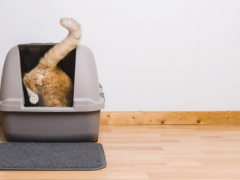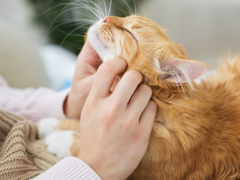
Kirsten McCarthy / Cats.com
Are you in a position where you need to change your cat’s food from wet to dry? Are you wondering how to go about making this a safe and smooth transition for both you and your cat? Read on to discover some useful tricks on how!
Cat owners change their pet's food for many reasons, including medical issues, safety, convenience, and financial choices. Switching a cat's food can be tricky, but a smooth transition is possible when you do it slowly. When switching foods, it's important to monitor how much your cat is eating to make sure they are getting adequate nutrition. If your cat won't eat the new food, or seems to have trouble eating it, talk to your veterinarian for advice.Key Takeaways
Cats can be notoriously difficult to please in the food department. If you have found a food that they seem to enjoy, it can be a hard decision to initiate a diet change. Cat owners change their pet’s food for many reasons, including medical reasons, safety, convenience, and financial choices. If you are going to change your cat’s food there are a few things you need to know to make the transition process as smooth as possible.
How Do You Rotate Wet and Dry Food for Cats?

Switching your cat’s food should be a gradual process to help your cat get used to the new food. Kate Barrington / Cats.com
Rotating your cat’s food involves much more than just picking the bowl up one day and placing it down the next with the new food in. You need to make sure it is a gradual, slow, and gentle transition.
Your cat might not welcome the change, so it might take a while for them to accept their new food. They might be more or less receptive depending on whether they are a kitten or adult cat.
When making a change, you might need to explore different flavors of the new type of food. Remember, your cat is an individual with their own likes and dislikes. You might think that they are turning their nose up at the new dry cat food you present to them, but actually, they just don’t like the new flavor. It’s a tricky business!
How To Help Your Cat’s Transition to Wet Cat Food
So how do you actually go about changing their food? The key is to do this process gradually in steps.
Step 1: Offer The New Food Alongside The Original Food
Feed your cat their normal food as you usually would. Next to their regular bowl put a small portion of the new food down, too. This is a way of introducing the new food and letting your cat know this strange-looking stuff is food as well. Don’t mix the food yet, it’s important to keep them separate for now.
Your cat might lick or eat the new food, if so great! If not, don’t worry at all. Your cat might not show any interest but that’s OK. It’s important just to let them get used to the new smell initially. When your cat does start to eat the new food, continue putting the new food and the old food alongside each other for at least three days before moving on to the next step.
Also Read: Do Cats Have A Good Sense Of Smell?
Step 2. Decrease The Amount Of Old Food And Increase The Amount Of New Food
Still keeping the two types of food separate, start to offer more of the new food and slightly less of the old food. It’s important not to mix the foods yet as the texture will be very different and you need to allow your cat time to adjust to the new texture.
If you mix the food too early, your cat might be put off and not eat any of it. Make sure that each time you increase the amount of new food, you wait until your cat is happily eating the entire portion before adding more.
Also Read: The 5 Best Elevated Cat Bowls
Step 3. Stop Using The Old Food
When your cat is happily eating the new food alongside the old food for a minimum of a week, you can phase out the old food completely. If your cat suddenly stops eating the new food, this might mean that you have gone through the steps too fast. If this is the case you go back a step or two for a while, then try again.
Reasons For Changing From Wet To Dry Food
There are many reasons you might switch your cat’s food from wet cat food to dry. Some of those reasons are listed below.
1. A Medical Reason
Certain medical conditions require or benefit from a specific diet. These include things like kidney failure, diabetes, arthritis, bladder stones or kidney stones, obesity, skin diseases, allergies, bowel problems, liver disorders, and hypo- or hyperthyroidism, or dental disease. Your cat might have a sensitive stomach due to a previous illness, too.
Your cat might have different metabolic requirements. For example, if they are pregnant, kitten food usually has a higher proportion of protein, fats, and carbohydrates compared to adult cat food and this is better suited to pregnant queens.
Also Read: The 7 Best Cat Food With Grains
2. Your Cat’s Tastes Might Have Changed
Your cat might suddenly decide they prefer a certain type of food. You might hear this from one of your neighbors who has spotted your cat eating their cat’s food for example. They might decide they just don’t like the food you give them anymore. This is usually after the food has been put on sale and you have bought it in bulk!
Also Read: My Cat Ate A Chicken Bone: Should I Worry?
3. Your Situation Might Have Changed
Your financial situation may have changed and you cannot afford the food you were giving them. Alternatively, you want to buy something of high quality for your cat that you previously couldn’t afford.
Additional Tips for a Smooth Transition Your Cat From Wet to Dry Food

If a cat has eaten only one type of food for their entire life, switching can be confusing for them. Kate Barrington / Cats.com
1. Don’t Rush
Imagine that it’s going to take about a month to do this properly—that way, you will be able to take your time and your cat won’t feel overwhelmed. Remember, the important thing is to make the change from wet food to dry food, it doesn’t matter how long this takes. It’s a marathon, not a sprint! Any drastic change will cause your cat unnecessary stress.
Also Read: Why Is My Cat Not Eating? Loss Of Appetite In Cats
2. Be Patient
Patience is definitely a virtue in this situation. You have to give your cat time to adjust. They might not even recognize the new diet as food at first. After all, it is a big change in texture and consistency. Your cat might have been on the old diet for their whole life and simply not know anything else. Some cats might be confused about the new food you are putting in front of them and not understand where their old food has gone.
Also Read: Why Do Cats Eat Plastic? (And How To Get Them To Stop)
3. Monitor Food Intake
Make sure you monitor what your cat is actually eating, especially in multi-cat households. Ensure your cat is still eating regularly and getting their daily calorie intake. If cats don’t eat for a couple of days in a row, they get something called hepatic lipidosis, also known as fatty liver disease. This is potentially fatal, so you must be careful.
Also Read: Can Cats Eat Lettuce?
4. Weigh Your Cat
It is very important to weigh your cat regularly during the process of switching their food. If they do not get enough nutrients and calories this will cause weight loss and will be detrimental to their health. By monitoring their weight closely, you can make sure they have a safe transition to their new cat food.
Also Read: Cat Weight Calculator
5. Prepare For Food Wastage
It might help if you resign yourself to the fact that you may well be wasting a lot of food while transitioning from wet to dry food. Your cat is very likely to leave some of their food each day as you change what’s offered to them. If you are prepared for this, it will stop you from getting stressed and frustrated.
Also Read: Wet vs. Dry Cat Food: What’s Better For Cats?
6. Never Change The Food Suddenly
Do not change 100% of your cat’s food suddenly unless you have been instructed to do so by your vet. Sudden changes in your cat’s diet are dangerous as they can cause them to have an upset tummy with vomiting and diarrhea.
Also Read: What Can You Give A Cat For An Upset Stomach?
7. Keep An Eye Out For Health Problems
There are a few reasons why your cat might not want to eat dry food. For example, if they have dental disease present, crunching hard kibble may hurt their mouth. If you are at all concerned about your cat’s health, consult your veterinarian.
Also, keep an eye on your cat if their hunger level changes. If they have a reduced appetite this might be because they are unwell as opposed to not liking the food you are offering.
Should You Alternate Wet and Dry Cat Food?
It’s beneficial for most cats to alternate between wet and dry cat food assuming your cat is accustomed to eating dry cat food and switching at once to wet cat food might be hard for her. This approach offers a smoother transition for your cat, and better control over dietary needs. Aim for a 50/50 ratio for the first few days, as wet food provides hydration, and dry food offers convenience and dental benefits. However, sudden changes might upset the stomach.
Cats are creatures of habit and usually resist changes in their diet. If you follow this guide with patience and give your cat all the time they need, you will be able to change their food from wet canned food to dry kibble even if they are the fussiest eater.
Also Read: How To Tell If A Cat Is Straining To Poop Or Pee
Frequently Asked Questions
Is it OK to mix wet and dry cat food?
The short answer to this is yes, you can mix dry and wet food. You have to be careful though as cats are very sensitive to texture. If you don't do it gradually, they might reject the food. Some cats might be more suited to wet or dry food, so consult your veterinarian before making any changes.
Can you switch cat food immediately?
It's very important not to make sudden changes to your cat's food unless your veterinarian has given you the green light. This is due to the fact that sudden changes can cause digestive upset and diarrhea. You may also give your cat an unwanted aversion unintentionally.
How many times a day should you feed a cat dry food?
It's usually normal for cats to eat two meals a day, spaced 12 hours apart. However, it's OK to feed around your schedule if you work shifts or have other commitments, as long as you stick to a routine for your cat. It's important to not go longer than 12 hours between feeds too as this can upset your cat's tummy.








Been feeding my cats RAW diet for years . Best thing we ever did. Our cats are healthier then they have ever been their now 19 and 21 years old and still running and playing. I would never feed my cats dry processed chemical filled dry kibble food again.